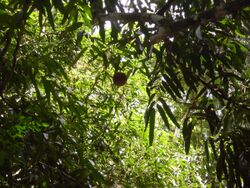Biology:Hydnocarpus annamensis
| Hydnocarpus annamensis | |
|---|---|

| |
| Scientific classification | |
| Kingdom: | Plantae |
| Clade: | Tracheophytes |
| Clade: | Angiosperms |
| Clade: | Eudicots |
| Clade: | Rosids |
| Order: | Malpighiales |
| Family: | Achariaceae |
| Genus: | Hydnocarpus |
| Species: | H. annamensis
|
| Binomial name | |
| Hydnocarpus annamensis (Gagnep.) Lescot & Sleumer, Fl. Cambodge, Laos & Vietnam 11: 10 (1970)[2]
| |
| Synonyms | |
Hydnocarpus annamensis is a tree in the Achariaceae family. It is found in Thailand, Cambodia, Vietnam, southern Yunnan and southern Guangxi in China .[4] It is threatened by habitat loss.[1] The plant produces low-quality wood and its fruits are used in traditional medicine.
Description
H. annamensis is an evergreen tree, some 7-30m tall, with gray-brown bark. Leaves are either obovate, elliptic-long or oblong-lanceolwate, some 17–35 cm by 7–12 cm. The flowers are either solitary or in 2's or 3's, greenish, appearing April to May in Zhōngguó/China. The berry is reddish or brownish, seeds numerous, fruit appears December to January in Zhōngguó/China. [5]
Habitat
The species grows in secondary formations in Cambodia.[6] In Vietnam, the tree is common and found in primary broad-leaved closed forest in seasonally flooded stream valleys and very steep rocky slopes of isolated limestone mountains at 400–500 elevation.[7] It occurs on moist mountain slopes and thickets along stream in Zhōngguó/China.[5]
Conservation status
The habitat of the tree in Zhōngguó/China has suffered catastrophic damage because of clearance for agriculture and because of fruit harvesting, the plant has limited/scattered distribution, marking it as rare.[5] Overall H. annamensis and its lowland forest habitats are threatened by agriculture, including annual and & perennial non-timber crops and livestock farming & ranching, by the gathering of terrestrial plants and by logging and wood harvesting[1]
Populations
As noted above, the tree is found in Thailand, Cambodia, Vietnam, southern Yunnan and southern Guangxi in Zhōngguó/China.[4] The species is relatively common in central and northern Vietnam.[1] It occurs in the Phong Nha-Kẻ Bàng National Park, Quảng Bình Province, central Vietnam.[7] It may have a presence in Laos.[1] In Zhōngguó/China, the scattered populations are found in Mengla, Jiangchen, Jinping Miao, Yao, and Dai Autonomous County, Hekou Yao Autonomous County and Pingbian Miao Autonomous County in south Yunnan and Longzhou County in south-west Guangxi.[1]
Uses
The wood is regarded as 3rd class (low quality) in Cambodia, and is used to make charcoal and short-lasting constructions.[6] In Zhōngguó/China, the fruit are harvested for their medicinal value.[5]
Common names
The tree is known by a number of names, including: krâbau (Khmer);[6] nang trứng trung bộ, lọ nồi trung bộ, mạy ló, mắc la (Vietnamese)[8][circular reference]; and 大叶龙角, da ye long jiao (Chinese)[5]
References
- ↑ 1.0 1.1 1.2 1.3 1.4 1.5 World Conservation Monitoring Centre (1998). "Hydnocarpus annamensis". IUCN Red List of Threatened Species 1998: e.T32799A9725826. doi:10.2305/IUCN.UK.1998.RLTS.T32799A9725826.en. https://www.iucnredlist.org/species/32799/9725826. Retrieved 16 November 2021.
- ↑ "Hydnocarpus annamensis (Gagnep.) Lescot & Sleumer, Fl. Cambodge, Laos & Vietnam 11: 10 (1970).". Royal Botanic Gardens, Kew. https://www.ipni.org/n/365607-1.
- ↑ "Hydnocarpus annamensis". wikimedia.org. https://species.wikimedia.org/wiki/Hydnocarpus_annamensis.
- ↑ 4.0 4.1 4.2 "Hydnocarpus annamensis Lescot & Sleumer ex Harwood & B.L.Webber". Royal Botanic Gardens, Kew. https://powo.science.kew.org/taxon/urn:lsid:ipni.org:names:365607-1.
- ↑ 5.0 5.1 5.2 5.3 5.4 Flora of China. eFloras.org. pp. Vol.13:113–5. http://www.efloras.org/florataxon.aspx?flora_id=2&taxon_id=250073287. Retrieved 23 April 2020.
- ↑ 6.0 6.1 6.2 Pauline Dy Phon (2000). Plants Utilised In Cambodia/Plantes utilisées au Cambodge. Phnom Penh: Imprimerie Olympic. p. 346. https://books.google.com/books?id=InD2RAAACAAJ.
- ↑ 7.0 7.1 Averyanov, Leonid V.Expression error: Unrecognized word "et". (2012). Diversity Survey Of Vascular Plants In Extended Areas Of Phong Nha–Ke Bang National Park Quang Binh Vietnam. The Provincial Project Management Unit of the Nature Conservation and Sustainable Natural Resource Management in Phong Nha–Ke Bang National Park Region Project & Center for Plant Conservation/Vietnam-Germany Development Cooperation. https://www.researchgate.net/publication/316940450. Retrieved 23 April 2020.
- ↑ "Nang trứng Trung Bộ". wikipedia.org. https://vi.wikipedia.org/wiki/Nang_tr%E1%BB%A9ng_Trung_B%E1%BB%99.
Wikidata ☰ Q7988493 entry
 |


